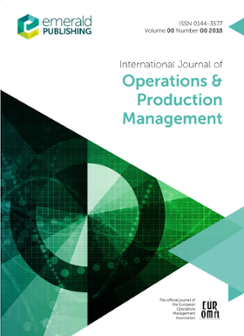数量优势:协同采购和精酿啤酒的竞争力
IF 7.4
2区 管理学
Q1 MANAGEMENT
International Journal of Operations & Production Management
Pub Date : 2023-08-11
DOI:10.1108/ijopm-08-2022-0503
引用次数: 0
摘要
本文旨在研究协作采购作为竞争小企业之间的采购策略,通过提高效率,议价能力和规模经济来降低其材料供应成本。设计/方法/方法将案例研究方法应用于区域性集群的啤酒厂网络。对来自生产商、供应商和行业专家的访谈数据进行归纳解释,以了解联合采购活动的可行性、组织影响和益处/局限性。研究发现,精酿行业采用差异化市场策略来获得竞争优势。这对供应链产生了影响,促进了原材料的多样性,这与标准化相冲突——标准化是集体购买的必要因素。竞争对信息共享和治理机制产生影响,供应链上下游规模不对称的结构性因素对收益产生影响。这些问题影响了协同采购的潜在经济效益。研究的局限性/含义研究主张已经在一个特定的行业发展,但可以推广到其他公司的差异化战略,特别是在消费品包装部门。在框架和能力矩阵中捕获了启用条件和约束,从业者可以使用它来评估协作采购的行业和产品可行性。以前对协作采购的研究是在大型组织的公共部门进行的。这项工作的重点是小企业背景下的合作,以确定这一战略的可行性和成本效益。本文章由计算机程序翻译,如有差异,请以英文原文为准。
Strength in numbers: collaborative procurement and competitiveness of craft breweries
Purpose This article aims to investigate collaborative procurement as a sourcing strategy amongst competing small enterprises in an effort to reduce their material supply costs through increased efficiencies, bargaining power and economies of scale. Design/methodology/approach A case study approach is applied to a network of breweries that are regionally clustered. Interview data from producers, suppliers and industry experts is inductively interpreted to understand the viability, organisational impact and benefits/limitations of joint procurement activities. Findings The craft brewing industry follows a market place strategy of differentiation to achieve competitive advantage. This has supply chain implications that promote raw material diversity, which is in conflict with standardisation – a necessary factor for collective buying. Competition impacts information sharing and governance mechanism, while the structural factors of size asymmetry along and across the supply chain influence returns. These issues impact the potential economic benefits of collaborative procurement. Research limitations/implications The research propositions have been developed in a specific industry but are generalisable to other companies with a differentiation strategy, especially in the consumer packaged goods sector. Practical implications Enabling conditions and constraints are captured in a framework and capability matrix, which can be used by practitioners to assess industry and product feasibility for collaborative procurement. Originality/value Previous studies of collaborative procurement have been in the public sector amongst large organisations. This work focusses on coopetition in the context of small businesses to identify the viability and cost-benefit of this strategy.
求助全文
通过发布文献求助,成功后即可免费获取论文全文。
去求助
来源期刊
CiteScore
13.30
自引率
17.20%
发文量
96
期刊介绍:
The mission of the International Journal of Operations & Production Management (IJOPM) is to publish cutting-edge, innovative research with the potential to significantly advance the field of Operations and Supply Chain Management, both in theory and practice. Drawing on experiences from manufacturing and service sectors, in both private and public contexts, the journal has earned widespread respect in this complex and increasingly vital area of business management.
Methodologically, IJOPM encompasses a broad spectrum of empirically-based inquiry using suitable research frameworks, as long as they offer generic insights of substantial value to operations and supply chain management. While the journal does not categorically exclude specific empirical methodologies, it does not accept purely mathematical modeling pieces. Regardless of the chosen mode of inquiry or methods employed, the key criteria are appropriateness of methodology, clarity in the study's execution, and rigor in the application of methods. It's important to note that any contribution should explicitly contribute to theory. The journal actively encourages the use of mixed methods where appropriate and valuable for generating research insights.

 求助内容:
求助内容: 应助结果提醒方式:
应助结果提醒方式:


